Media Discourse, Women Empowerment: Foundation of Communication Essay
VerifiedAdded on 2022/08/25
|11
|2835
|20
Essay
AI Summary
This essay explores the impact of media discourse on women empowerment and femininity, drawing upon the theoretical frameworks of Michel Foucault and Erving Goffman. It examines how media platforms contribute to shaping public opinion and facilitating social transformation. The essay analyzes the discourses related to politics, culture, and social aspects, and it explores the power dynamics and historical precedents that influence how we perceive women's roles in society. It investigates the application of Goffman's theories of self-presentation to social media platforms like Facebook and Instagram, analyzing how women create impressions and manage their identities online. Additionally, the essay considers the concept of 'over-sharing' in the context of social media and its effects on personal and professional lives. The essay uses discourse analysis to examine the relationship between women, media, and the construction of femininity, providing insights into the evolving landscape of communication and social interaction.
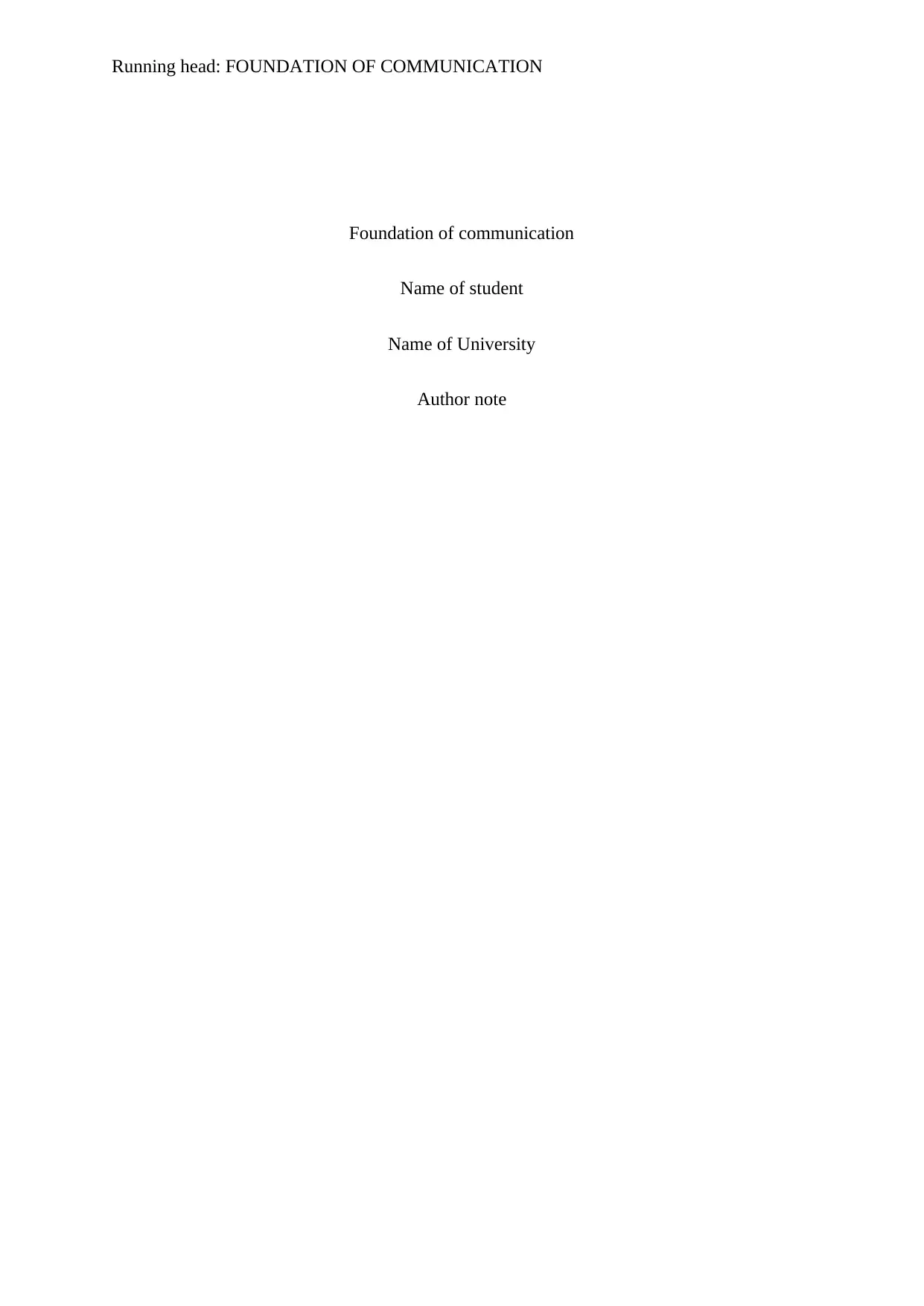
Running head: FOUNDATION OF COMMUNICATION
Foundation of communication
Name of student
Name of University
Author note
Foundation of communication
Name of student
Name of University
Author note
Paraphrase This Document
Need a fresh take? Get an instant paraphrase of this document with our AI Paraphraser
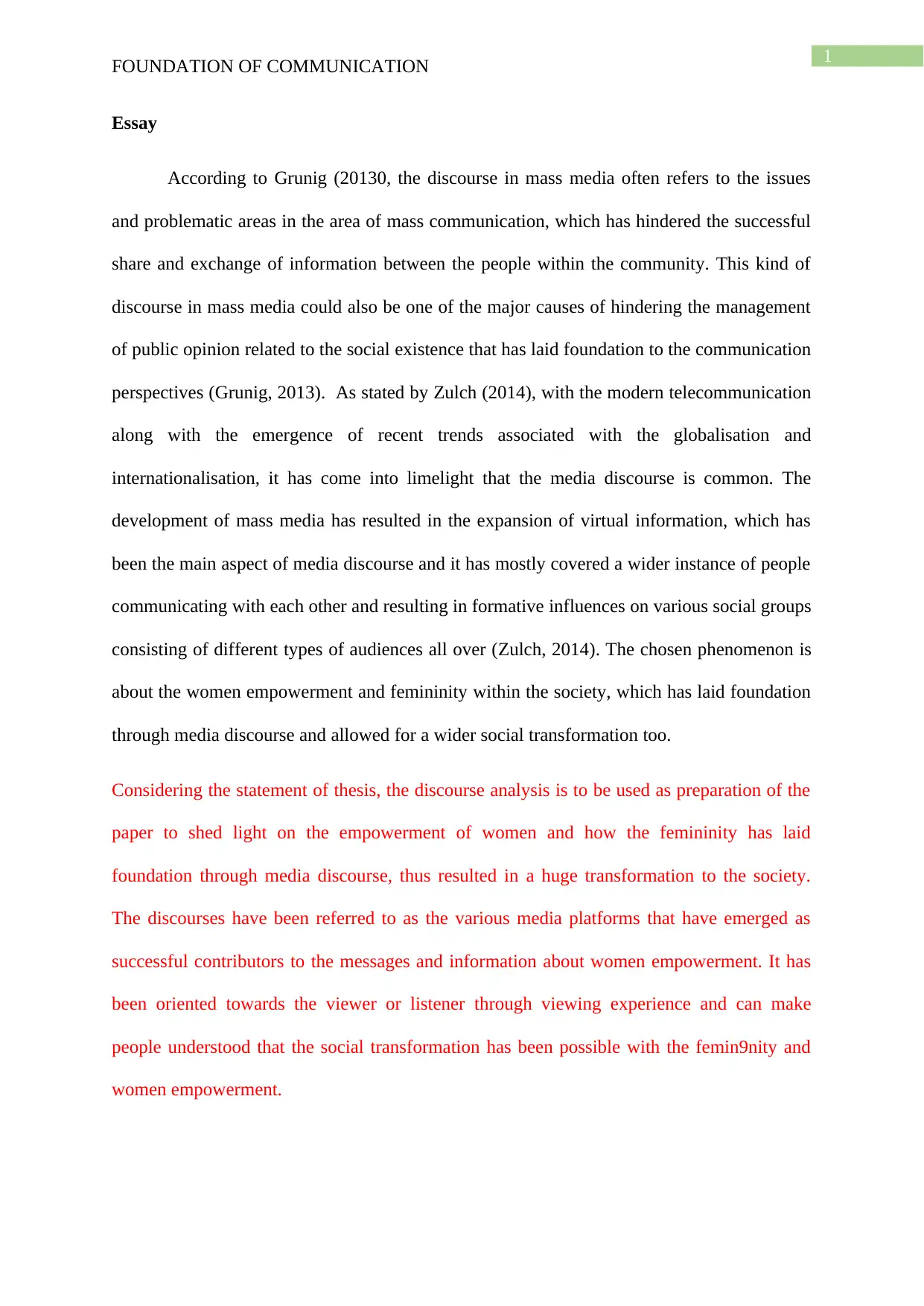
1
FOUNDATION OF COMMUNICATION
Essay
According to Grunig (20130, the discourse in mass media often refers to the issues
and problematic areas in the area of mass communication, which has hindered the successful
share and exchange of information between the people within the community. This kind of
discourse in mass media could also be one of the major causes of hindering the management
of public opinion related to the social existence that has laid foundation to the communication
perspectives (Grunig, 2013). As stated by Zulch (2014), with the modern telecommunication
along with the emergence of recent trends associated with the globalisation and
internationalisation, it has come into limelight that the media discourse is common. The
development of mass media has resulted in the expansion of virtual information, which has
been the main aspect of media discourse and it has mostly covered a wider instance of people
communicating with each other and resulting in formative influences on various social groups
consisting of different types of audiences all over (Zulch, 2014). The chosen phenomenon is
about the women empowerment and femininity within the society, which has laid foundation
through media discourse and allowed for a wider social transformation too.
Considering the statement of thesis, the discourse analysis is to be used as preparation of the
paper to shed light on the empowerment of women and how the femininity has laid
foundation through media discourse, thus resulted in a huge transformation to the society.
The discourses have been referred to as the various media platforms that have emerged as
successful contributors to the messages and information about women empowerment. It has
been oriented towards the viewer or listener through viewing experience and can make
people understood that the social transformation has been possible with the femin9nity and
women empowerment.
FOUNDATION OF COMMUNICATION
Essay
According to Grunig (20130, the discourse in mass media often refers to the issues
and problematic areas in the area of mass communication, which has hindered the successful
share and exchange of information between the people within the community. This kind of
discourse in mass media could also be one of the major causes of hindering the management
of public opinion related to the social existence that has laid foundation to the communication
perspectives (Grunig, 2013). As stated by Zulch (2014), with the modern telecommunication
along with the emergence of recent trends associated with the globalisation and
internationalisation, it has come into limelight that the media discourse is common. The
development of mass media has resulted in the expansion of virtual information, which has
been the main aspect of media discourse and it has mostly covered a wider instance of people
communicating with each other and resulting in formative influences on various social groups
consisting of different types of audiences all over (Zulch, 2014). The chosen phenomenon is
about the women empowerment and femininity within the society, which has laid foundation
through media discourse and allowed for a wider social transformation too.
Considering the statement of thesis, the discourse analysis is to be used as preparation of the
paper to shed light on the empowerment of women and how the femininity has laid
foundation through media discourse, thus resulted in a huge transformation to the society.
The discourses have been referred to as the various media platforms that have emerged as
successful contributors to the messages and information about women empowerment. It has
been oriented towards the viewer or listener through viewing experience and can make
people understood that the social transformation has been possible with the femin9nity and
women empowerment.
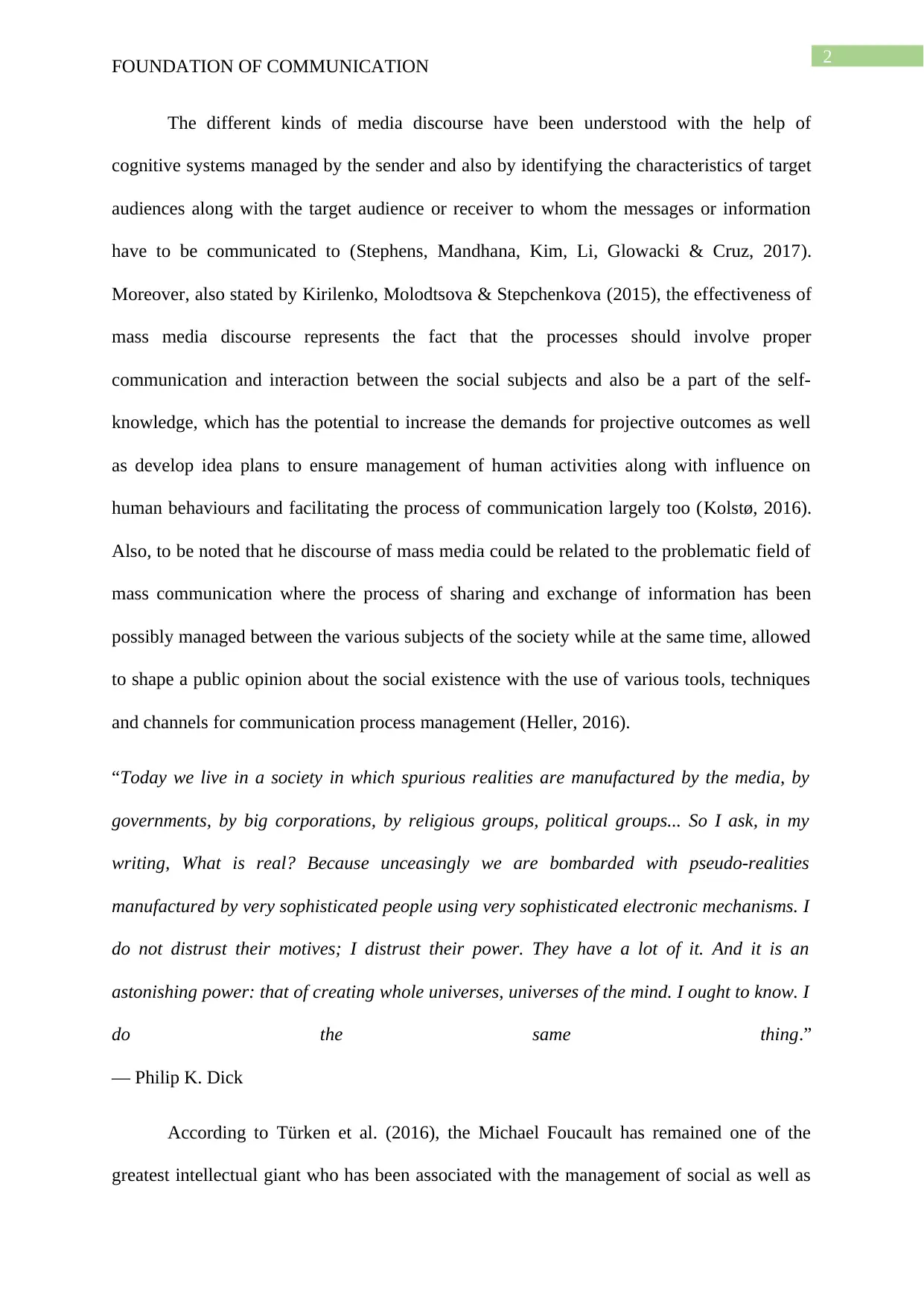
2
FOUNDATION OF COMMUNICATION
The different kinds of media discourse have been understood with the help of
cognitive systems managed by the sender and also by identifying the characteristics of target
audiences along with the target audience or receiver to whom the messages or information
have to be communicated to (Stephens, Mandhana, Kim, Li, Glowacki & Cruz, 2017).
Moreover, also stated by Kirilenko, Molodtsova & Stepchenkova (2015), the effectiveness of
mass media discourse represents the fact that the processes should involve proper
communication and interaction between the social subjects and also be a part of the self-
knowledge, which has the potential to increase the demands for projective outcomes as well
as develop idea plans to ensure management of human activities along with influence on
human behaviours and facilitating the process of communication largely too (Kolstø, 2016).
Also, to be noted that he discourse of mass media could be related to the problematic field of
mass communication where the process of sharing and exchange of information has been
possibly managed between the various subjects of the society while at the same time, allowed
to shape a public opinion about the social existence with the use of various tools, techniques
and channels for communication process management (Heller, 2016).
“Today we live in a society in which spurious realities are manufactured by the media, by
governments, by big corporations, by religious groups, political groups... So I ask, in my
writing, What is real? Because unceasingly we are bombarded with pseudo-realities
manufactured by very sophisticated people using very sophisticated electronic mechanisms. I
do not distrust their motives; I distrust their power. They have a lot of it. And it is an
astonishing power: that of creating whole universes, universes of the mind. I ought to know. I
do the same thing.”
― Philip K. Dick
According to Türken et al. (2016), the Michael Foucault has remained one of the
greatest intellectual giant who has been associated with the management of social as well as
FOUNDATION OF COMMUNICATION
The different kinds of media discourse have been understood with the help of
cognitive systems managed by the sender and also by identifying the characteristics of target
audiences along with the target audience or receiver to whom the messages or information
have to be communicated to (Stephens, Mandhana, Kim, Li, Glowacki & Cruz, 2017).
Moreover, also stated by Kirilenko, Molodtsova & Stepchenkova (2015), the effectiveness of
mass media discourse represents the fact that the processes should involve proper
communication and interaction between the social subjects and also be a part of the self-
knowledge, which has the potential to increase the demands for projective outcomes as well
as develop idea plans to ensure management of human activities along with influence on
human behaviours and facilitating the process of communication largely too (Kolstø, 2016).
Also, to be noted that he discourse of mass media could be related to the problematic field of
mass communication where the process of sharing and exchange of information has been
possibly managed between the various subjects of the society while at the same time, allowed
to shape a public opinion about the social existence with the use of various tools, techniques
and channels for communication process management (Heller, 2016).
“Today we live in a society in which spurious realities are manufactured by the media, by
governments, by big corporations, by religious groups, political groups... So I ask, in my
writing, What is real? Because unceasingly we are bombarded with pseudo-realities
manufactured by very sophisticated people using very sophisticated electronic mechanisms. I
do not distrust their motives; I distrust their power. They have a lot of it. And it is an
astonishing power: that of creating whole universes, universes of the mind. I ought to know. I
do the same thing.”
― Philip K. Dick
According to Türken et al. (2016), the Michael Foucault has remained one of the
greatest intellectual giant who has been associated with the management of social as well as
⊘ This is a preview!⊘
Do you want full access?
Subscribe today to unlock all pages.

Trusted by 1+ million students worldwide
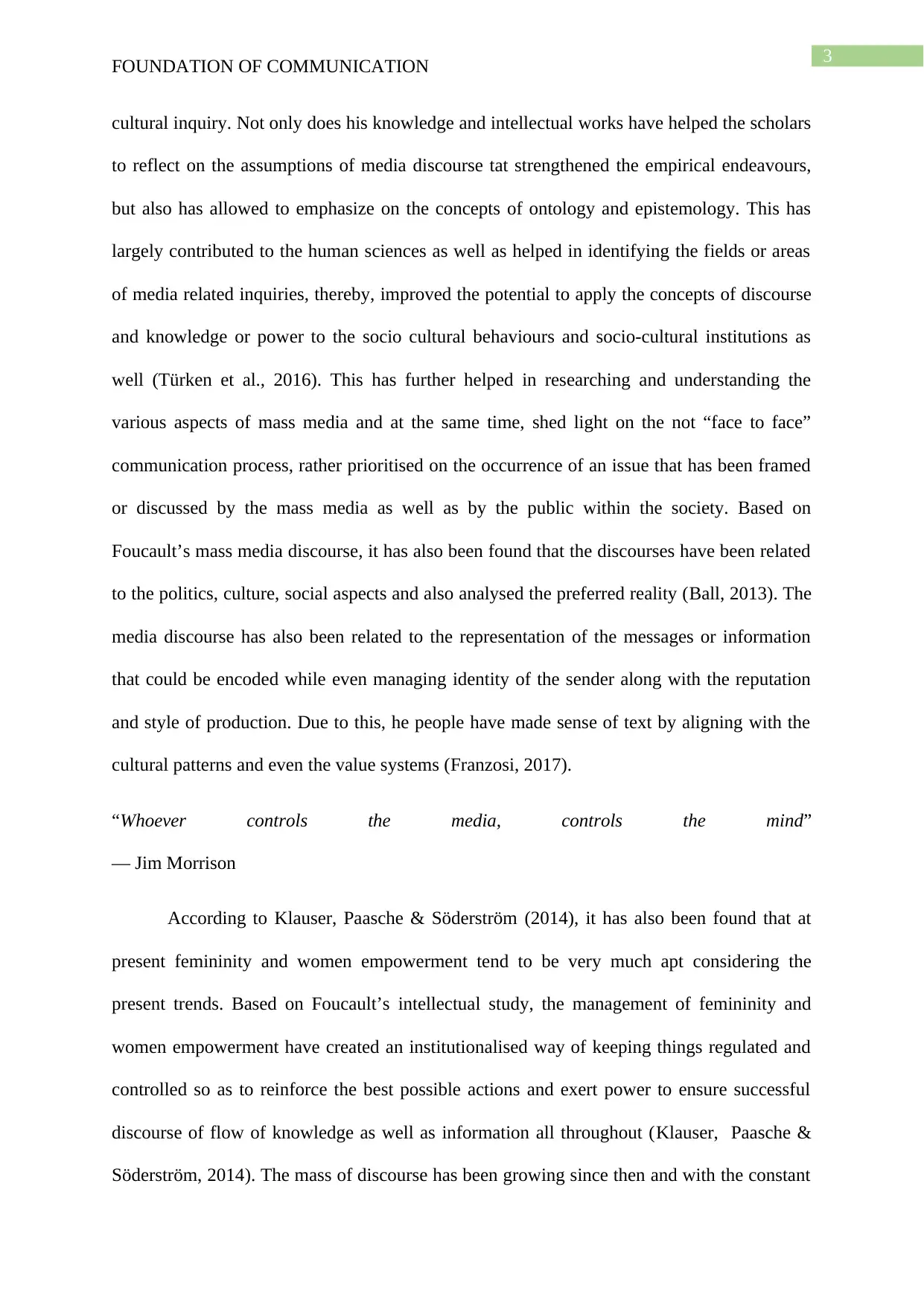
3
FOUNDATION OF COMMUNICATION
cultural inquiry. Not only does his knowledge and intellectual works have helped the scholars
to reflect on the assumptions of media discourse tat strengthened the empirical endeavours,
but also has allowed to emphasize on the concepts of ontology and epistemology. This has
largely contributed to the human sciences as well as helped in identifying the fields or areas
of media related inquiries, thereby, improved the potential to apply the concepts of discourse
and knowledge or power to the socio cultural behaviours and socio-cultural institutions as
well (Türken et al., 2016). This has further helped in researching and understanding the
various aspects of mass media and at the same time, shed light on the not “face to face”
communication process, rather prioritised on the occurrence of an issue that has been framed
or discussed by the mass media as well as by the public within the society. Based on
Foucault’s mass media discourse, it has also been found that the discourses have been related
to the politics, culture, social aspects and also analysed the preferred reality (Ball, 2013). The
media discourse has also been related to the representation of the messages or information
that could be encoded while even managing identity of the sender along with the reputation
and style of production. Due to this, he people have made sense of text by aligning with the
cultural patterns and even the value systems (Franzosi, 2017).
“Whoever controls the media, controls the mind”
― Jim Morrison
According to Klauser, Paasche & Söderström (2014), it has also been found that at
present femininity and women empowerment tend to be very much apt considering the
present trends. Based on Foucault’s intellectual study, the management of femininity and
women empowerment have created an institutionalised way of keeping things regulated and
controlled so as to reinforce the best possible actions and exert power to ensure successful
discourse of flow of knowledge as well as information all throughout (Klauser, Paasche &
Söderström, 2014). The mass of discourse has been growing since then and with the constant
FOUNDATION OF COMMUNICATION
cultural inquiry. Not only does his knowledge and intellectual works have helped the scholars
to reflect on the assumptions of media discourse tat strengthened the empirical endeavours,
but also has allowed to emphasize on the concepts of ontology and epistemology. This has
largely contributed to the human sciences as well as helped in identifying the fields or areas
of media related inquiries, thereby, improved the potential to apply the concepts of discourse
and knowledge or power to the socio cultural behaviours and socio-cultural institutions as
well (Türken et al., 2016). This has further helped in researching and understanding the
various aspects of mass media and at the same time, shed light on the not “face to face”
communication process, rather prioritised on the occurrence of an issue that has been framed
or discussed by the mass media as well as by the public within the society. Based on
Foucault’s mass media discourse, it has also been found that the discourses have been related
to the politics, culture, social aspects and also analysed the preferred reality (Ball, 2013). The
media discourse has also been related to the representation of the messages or information
that could be encoded while even managing identity of the sender along with the reputation
and style of production. Due to this, he people have made sense of text by aligning with the
cultural patterns and even the value systems (Franzosi, 2017).
“Whoever controls the media, controls the mind”
― Jim Morrison
According to Klauser, Paasche & Söderström (2014), it has also been found that at
present femininity and women empowerment tend to be very much apt considering the
present trends. Based on Foucault’s intellectual study, the management of femininity and
women empowerment have created an institutionalised way of keeping things regulated and
controlled so as to reinforce the best possible actions and exert power to ensure successful
discourse of flow of knowledge as well as information all throughout (Klauser, Paasche &
Söderström, 2014). The mass of discourse has been growing since then and with the constant
Paraphrase This Document
Need a fresh take? Get an instant paraphrase of this document with our AI Paraphraser

4
FOUNDATION OF COMMUNICATION
growth, there have been much more speculations regarding how the exertion of power has
been possible with the society through institutionalisation and regulation of ways and
approaches to think, talk as well as act. The production of discourse and management of
contingent knowledge and information have been central for Foucault, which not only
examined the discourse related to power, but also has linked it with the reality based on the
active subjects at present (Li, Matouschek & Powell, 2017). The essay, thus drew on the
concepts of Foucault regarding power, power knowledge and discourse of mass media for
analysing the relationship between women and media and it has formed constructions of
femininity too.
“The average TV commercial of sixty seconds has one hundred and twenty half-second clips
in it, or one-third of a second. We bombard people with sensation. That substitutes for
thinking.”
― Ray Bradbury
The mass media has emphasized on this phenomenon quite aggressively and due to
this, this is become the centre of mass media and cultural discourse and ensured fulfilment of
physical activities properly too. The power dynamics, as stated by Klauser, Paasche &
Söderström (2014), has also created influence on people, especially the women to come up
with greater roles and responsibilities and also enjoy lives like others. This has provided the
women with opportunity to rule, empower, make decisions and also create new things. The
power dynamics related to the femininity and women empowerment has resulted in getting
better access to natural and intellectual resources while at the same time, ensured undertaking
an approach to promote women power and influence intellectualisation and strategization as a
whole.
FOUNDATION OF COMMUNICATION
growth, there have been much more speculations regarding how the exertion of power has
been possible with the society through institutionalisation and regulation of ways and
approaches to think, talk as well as act. The production of discourse and management of
contingent knowledge and information have been central for Foucault, which not only
examined the discourse related to power, but also has linked it with the reality based on the
active subjects at present (Li, Matouschek & Powell, 2017). The essay, thus drew on the
concepts of Foucault regarding power, power knowledge and discourse of mass media for
analysing the relationship between women and media and it has formed constructions of
femininity too.
“The average TV commercial of sixty seconds has one hundred and twenty half-second clips
in it, or one-third of a second. We bombard people with sensation. That substitutes for
thinking.”
― Ray Bradbury
The mass media has emphasized on this phenomenon quite aggressively and due to
this, this is become the centre of mass media and cultural discourse and ensured fulfilment of
physical activities properly too. The power dynamics, as stated by Klauser, Paasche &
Söderström (2014), has also created influence on people, especially the women to come up
with greater roles and responsibilities and also enjoy lives like others. This has provided the
women with opportunity to rule, empower, make decisions and also create new things. The
power dynamics related to the femininity and women empowerment has resulted in getting
better access to natural and intellectual resources while at the same time, ensured undertaking
an approach to promote women power and influence intellectualisation and strategization as a
whole.
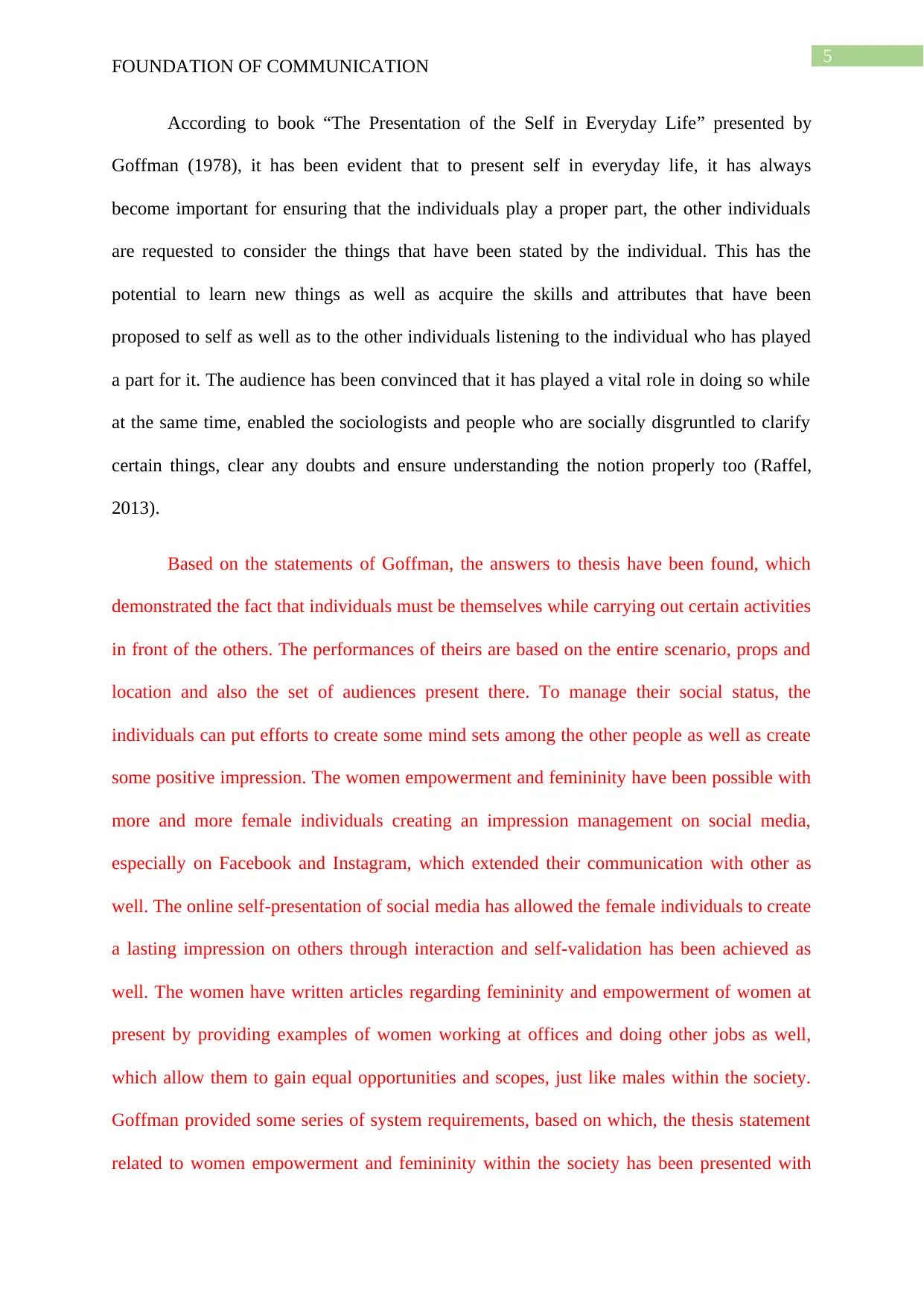
5
FOUNDATION OF COMMUNICATION
According to book “The Presentation of the Self in Everyday Life” presented by
Goffman (1978), it has been evident that to present self in everyday life, it has always
become important for ensuring that the individuals play a proper part, the other individuals
are requested to consider the things that have been stated by the individual. This has the
potential to learn new things as well as acquire the skills and attributes that have been
proposed to self as well as to the other individuals listening to the individual who has played
a part for it. The audience has been convinced that it has played a vital role in doing so while
at the same time, enabled the sociologists and people who are socially disgruntled to clarify
certain things, clear any doubts and ensure understanding the notion properly too (Raffel,
2013).
Based on the statements of Goffman, the answers to thesis have been found, which
demonstrated the fact that individuals must be themselves while carrying out certain activities
in front of the others. The performances of theirs are based on the entire scenario, props and
location and also the set of audiences present there. To manage their social status, the
individuals can put efforts to create some mind sets among the other people as well as create
some positive impression. The women empowerment and femininity have been possible with
more and more female individuals creating an impression management on social media,
especially on Facebook and Instagram, which extended their communication with other as
well. The online self-presentation of social media has allowed the female individuals to create
a lasting impression on others through interaction and self-validation has been achieved as
well. The women have written articles regarding femininity and empowerment of women at
present by providing examples of women working at offices and doing other jobs as well,
which allow them to gain equal opportunities and scopes, just like males within the society.
Goffman provided some series of system requirements, based on which, the thesis statement
related to women empowerment and femininity within the society has been presented with
FOUNDATION OF COMMUNICATION
According to book “The Presentation of the Self in Everyday Life” presented by
Goffman (1978), it has been evident that to present self in everyday life, it has always
become important for ensuring that the individuals play a proper part, the other individuals
are requested to consider the things that have been stated by the individual. This has the
potential to learn new things as well as acquire the skills and attributes that have been
proposed to self as well as to the other individuals listening to the individual who has played
a part for it. The audience has been convinced that it has played a vital role in doing so while
at the same time, enabled the sociologists and people who are socially disgruntled to clarify
certain things, clear any doubts and ensure understanding the notion properly too (Raffel,
2013).
Based on the statements of Goffman, the answers to thesis have been found, which
demonstrated the fact that individuals must be themselves while carrying out certain activities
in front of the others. The performances of theirs are based on the entire scenario, props and
location and also the set of audiences present there. To manage their social status, the
individuals can put efforts to create some mind sets among the other people as well as create
some positive impression. The women empowerment and femininity have been possible with
more and more female individuals creating an impression management on social media,
especially on Facebook and Instagram, which extended their communication with other as
well. The online self-presentation of social media has allowed the female individuals to create
a lasting impression on others through interaction and self-validation has been achieved as
well. The women have written articles regarding femininity and empowerment of women at
present by providing examples of women working at offices and doing other jobs as well,
which allow them to gain equal opportunities and scopes, just like males within the society.
Goffman provided some series of system requirements, based on which, the thesis statement
related to women empowerment and femininity within the society has been presented with
⊘ This is a preview!⊘
Do you want full access?
Subscribe today to unlock all pages.

Trusted by 1+ million students worldwide
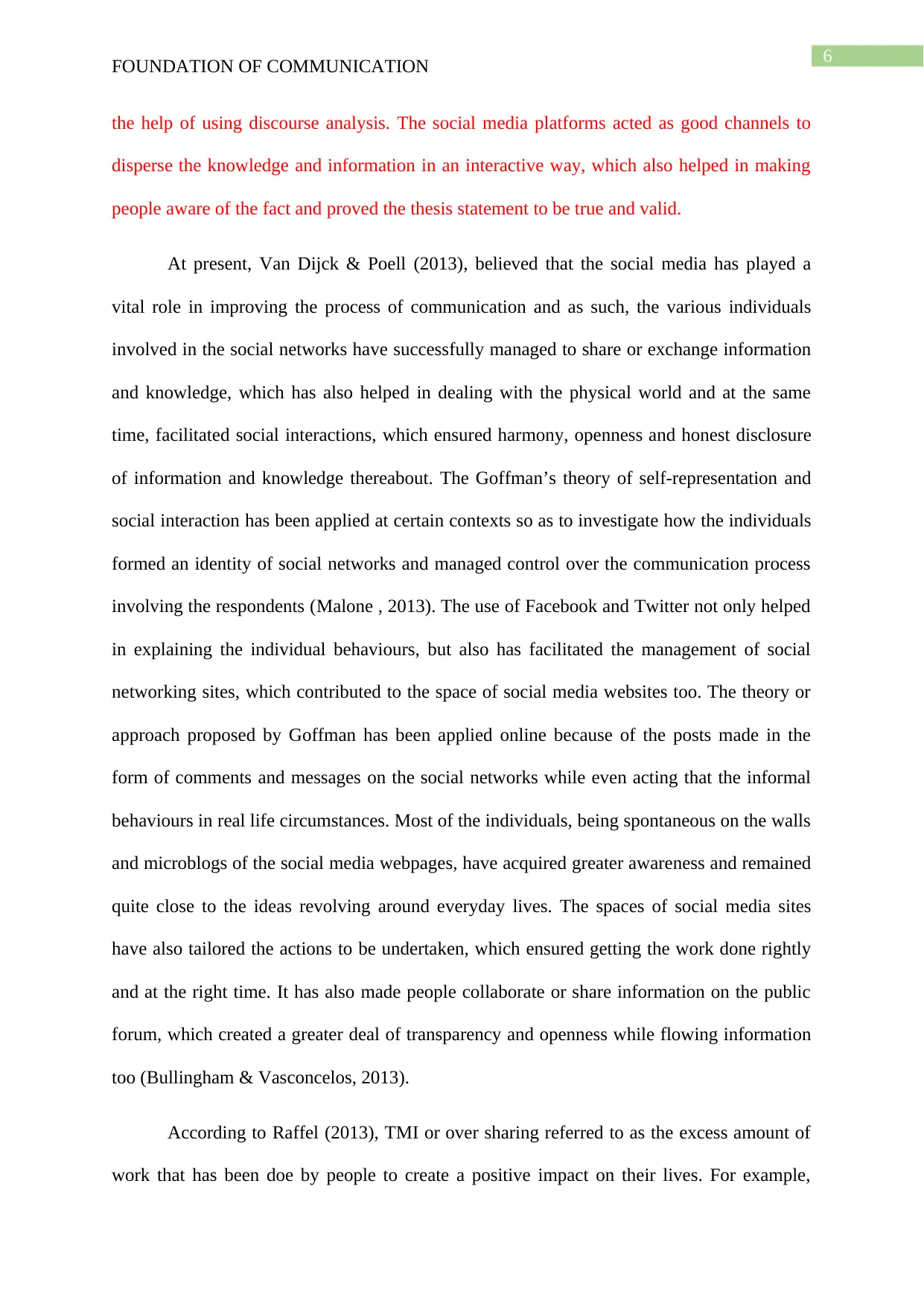
6
FOUNDATION OF COMMUNICATION
the help of using discourse analysis. The social media platforms acted as good channels to
disperse the knowledge and information in an interactive way, which also helped in making
people aware of the fact and proved the thesis statement to be true and valid.
At present, Van Dijck & Poell (2013), believed that the social media has played a
vital role in improving the process of communication and as such, the various individuals
involved in the social networks have successfully managed to share or exchange information
and knowledge, which has also helped in dealing with the physical world and at the same
time, facilitated social interactions, which ensured harmony, openness and honest disclosure
of information and knowledge thereabout. The Goffman’s theory of self-representation and
social interaction has been applied at certain contexts so as to investigate how the individuals
formed an identity of social networks and managed control over the communication process
involving the respondents (Malone , 2013). The use of Facebook and Twitter not only helped
in explaining the individual behaviours, but also has facilitated the management of social
networking sites, which contributed to the space of social media websites too. The theory or
approach proposed by Goffman has been applied online because of the posts made in the
form of comments and messages on the social networks while even acting that the informal
behaviours in real life circumstances. Most of the individuals, being spontaneous on the walls
and microblogs of the social media webpages, have acquired greater awareness and remained
quite close to the ideas revolving around everyday lives. The spaces of social media sites
have also tailored the actions to be undertaken, which ensured getting the work done rightly
and at the right time. It has also made people collaborate or share information on the public
forum, which created a greater deal of transparency and openness while flowing information
too (Bullingham & Vasconcelos, 2013).
According to Raffel (2013), TMI or over sharing referred to as the excess amount of
work that has been doe by people to create a positive impact on their lives. For example,
FOUNDATION OF COMMUNICATION
the help of using discourse analysis. The social media platforms acted as good channels to
disperse the knowledge and information in an interactive way, which also helped in making
people aware of the fact and proved the thesis statement to be true and valid.
At present, Van Dijck & Poell (2013), believed that the social media has played a
vital role in improving the process of communication and as such, the various individuals
involved in the social networks have successfully managed to share or exchange information
and knowledge, which has also helped in dealing with the physical world and at the same
time, facilitated social interactions, which ensured harmony, openness and honest disclosure
of information and knowledge thereabout. The Goffman’s theory of self-representation and
social interaction has been applied at certain contexts so as to investigate how the individuals
formed an identity of social networks and managed control over the communication process
involving the respondents (Malone , 2013). The use of Facebook and Twitter not only helped
in explaining the individual behaviours, but also has facilitated the management of social
networking sites, which contributed to the space of social media websites too. The theory or
approach proposed by Goffman has been applied online because of the posts made in the
form of comments and messages on the social networks while even acting that the informal
behaviours in real life circumstances. Most of the individuals, being spontaneous on the walls
and microblogs of the social media webpages, have acquired greater awareness and remained
quite close to the ideas revolving around everyday lives. The spaces of social media sites
have also tailored the actions to be undertaken, which ensured getting the work done rightly
and at the right time. It has also made people collaborate or share information on the public
forum, which created a greater deal of transparency and openness while flowing information
too (Bullingham & Vasconcelos, 2013).
According to Raffel (2013), TMI or over sharing referred to as the excess amount of
work that has been doe by people to create a positive impact on their lives. For example,
Paraphrase This Document
Need a fresh take? Get an instant paraphrase of this document with our AI Paraphraser
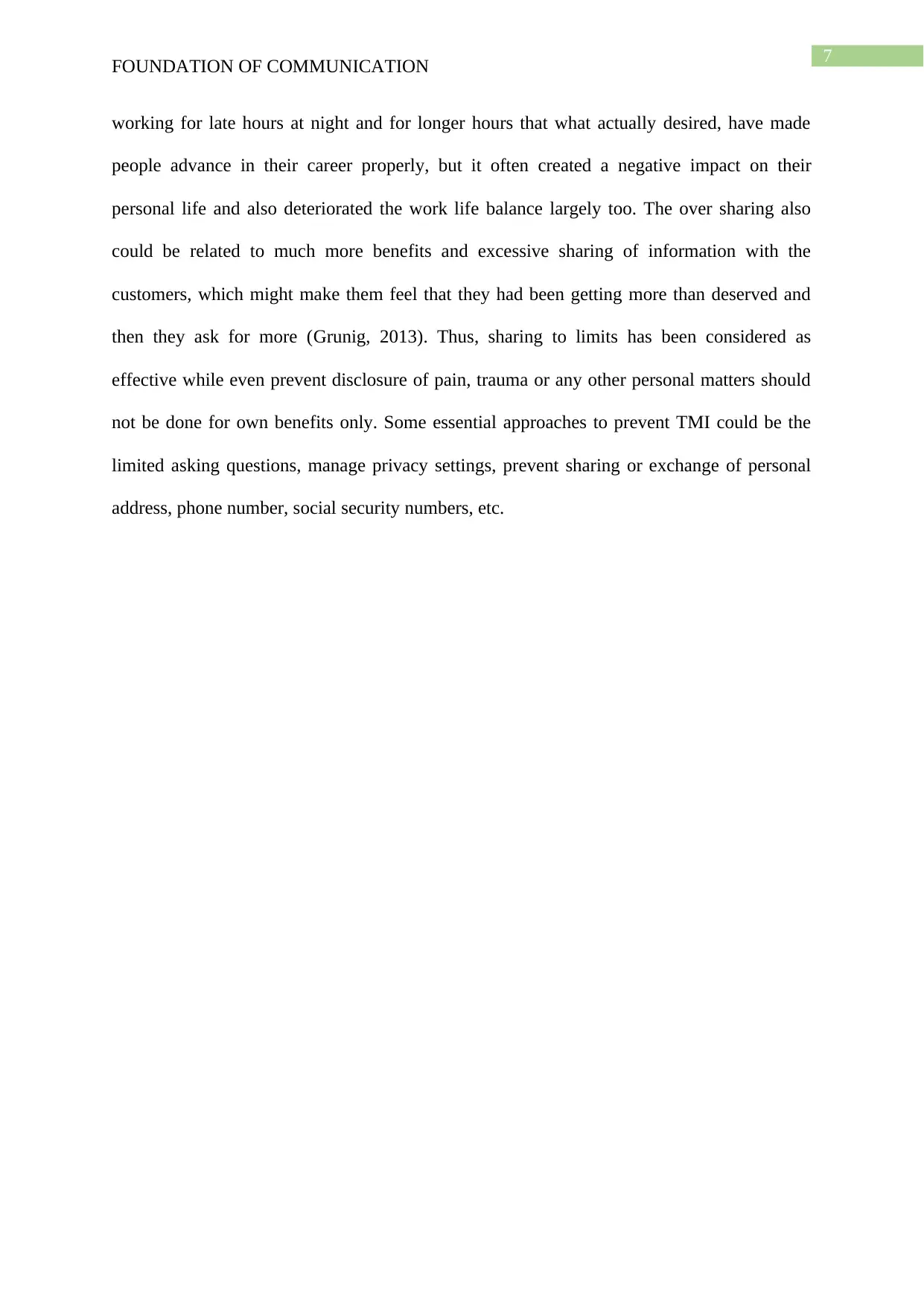
7
FOUNDATION OF COMMUNICATION
working for late hours at night and for longer hours that what actually desired, have made
people advance in their career properly, but it often created a negative impact on their
personal life and also deteriorated the work life balance largely too. The over sharing also
could be related to much more benefits and excessive sharing of information with the
customers, which might make them feel that they had been getting more than deserved and
then they ask for more (Grunig, 2013). Thus, sharing to limits has been considered as
effective while even prevent disclosure of pain, trauma or any other personal matters should
not be done for own benefits only. Some essential approaches to prevent TMI could be the
limited asking questions, manage privacy settings, prevent sharing or exchange of personal
address, phone number, social security numbers, etc.
FOUNDATION OF COMMUNICATION
working for late hours at night and for longer hours that what actually desired, have made
people advance in their career properly, but it often created a negative impact on their
personal life and also deteriorated the work life balance largely too. The over sharing also
could be related to much more benefits and excessive sharing of information with the
customers, which might make them feel that they had been getting more than deserved and
then they ask for more (Grunig, 2013). Thus, sharing to limits has been considered as
effective while even prevent disclosure of pain, trauma or any other personal matters should
not be done for own benefits only. Some essential approaches to prevent TMI could be the
limited asking questions, manage privacy settings, prevent sharing or exchange of personal
address, phone number, social security numbers, etc.
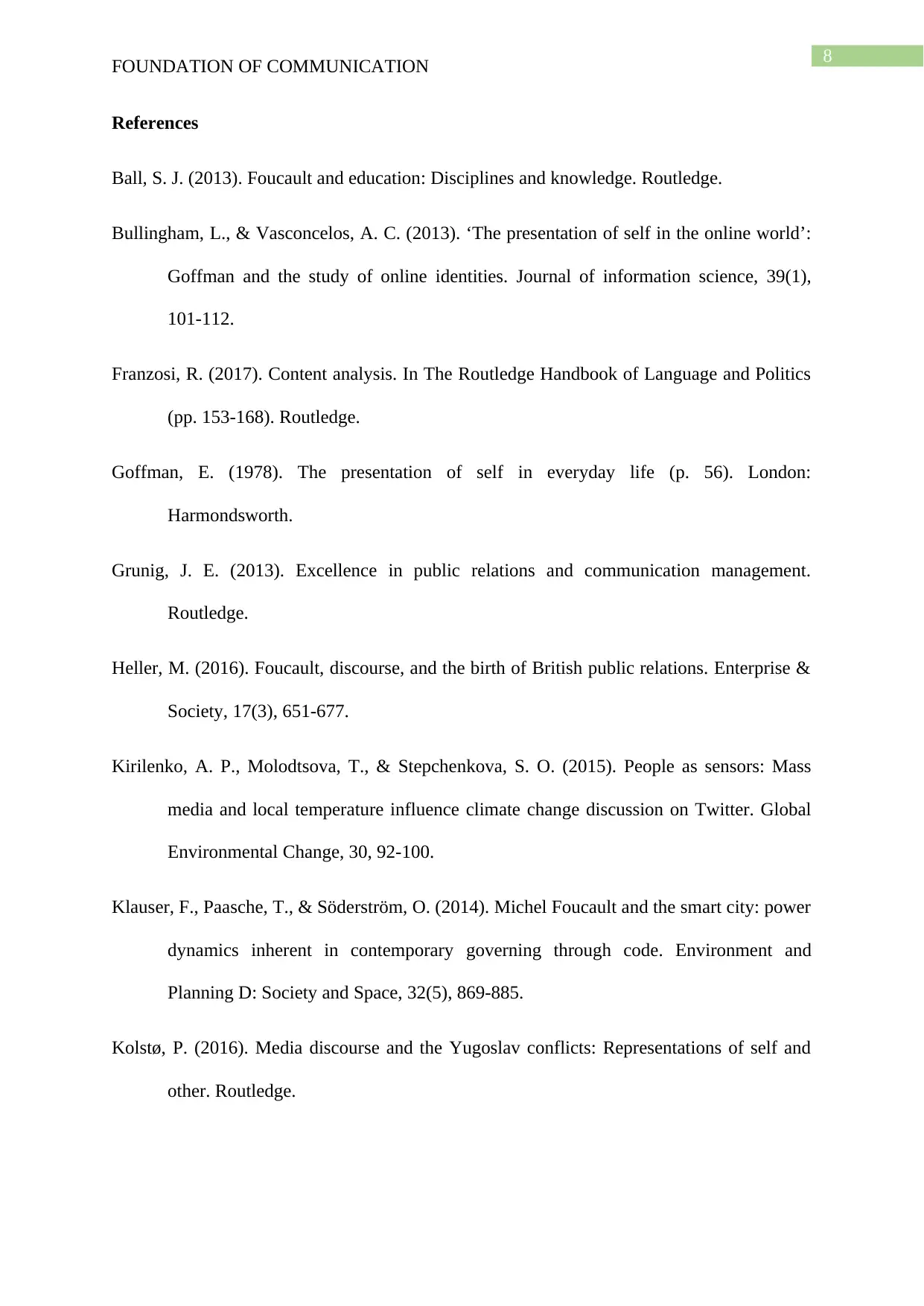
8
FOUNDATION OF COMMUNICATION
References
Ball, S. J. (2013). Foucault and education: Disciplines and knowledge. Routledge.
Bullingham, L., & Vasconcelos, A. C. (2013). ‘The presentation of self in the online world’:
Goffman and the study of online identities. Journal of information science, 39(1),
101-112.
Franzosi, R. (2017). Content analysis. In The Routledge Handbook of Language and Politics
(pp. 153-168). Routledge.
Goffman, E. (1978). The presentation of self in everyday life (p. 56). London:
Harmondsworth.
Grunig, J. E. (2013). Excellence in public relations and communication management.
Routledge.
Heller, M. (2016). Foucault, discourse, and the birth of British public relations. Enterprise &
Society, 17(3), 651-677.
Kirilenko, A. P., Molodtsova, T., & Stepchenkova, S. O. (2015). People as sensors: Mass
media and local temperature influence climate change discussion on Twitter. Global
Environmental Change, 30, 92-100.
Klauser, F., Paasche, T., & Söderström, O. (2014). Michel Foucault and the smart city: power
dynamics inherent in contemporary governing through code. Environment and
Planning D: Society and Space, 32(5), 869-885.
Kolstø, P. (2016). Media discourse and the Yugoslav conflicts: Representations of self and
other. Routledge.
FOUNDATION OF COMMUNICATION
References
Ball, S. J. (2013). Foucault and education: Disciplines and knowledge. Routledge.
Bullingham, L., & Vasconcelos, A. C. (2013). ‘The presentation of self in the online world’:
Goffman and the study of online identities. Journal of information science, 39(1),
101-112.
Franzosi, R. (2017). Content analysis. In The Routledge Handbook of Language and Politics
(pp. 153-168). Routledge.
Goffman, E. (1978). The presentation of self in everyday life (p. 56). London:
Harmondsworth.
Grunig, J. E. (2013). Excellence in public relations and communication management.
Routledge.
Heller, M. (2016). Foucault, discourse, and the birth of British public relations. Enterprise &
Society, 17(3), 651-677.
Kirilenko, A. P., Molodtsova, T., & Stepchenkova, S. O. (2015). People as sensors: Mass
media and local temperature influence climate change discussion on Twitter. Global
Environmental Change, 30, 92-100.
Klauser, F., Paasche, T., & Söderström, O. (2014). Michel Foucault and the smart city: power
dynamics inherent in contemporary governing through code. Environment and
Planning D: Society and Space, 32(5), 869-885.
Kolstø, P. (2016). Media discourse and the Yugoslav conflicts: Representations of self and
other. Routledge.
⊘ This is a preview!⊘
Do you want full access?
Subscribe today to unlock all pages.

Trusted by 1+ million students worldwide
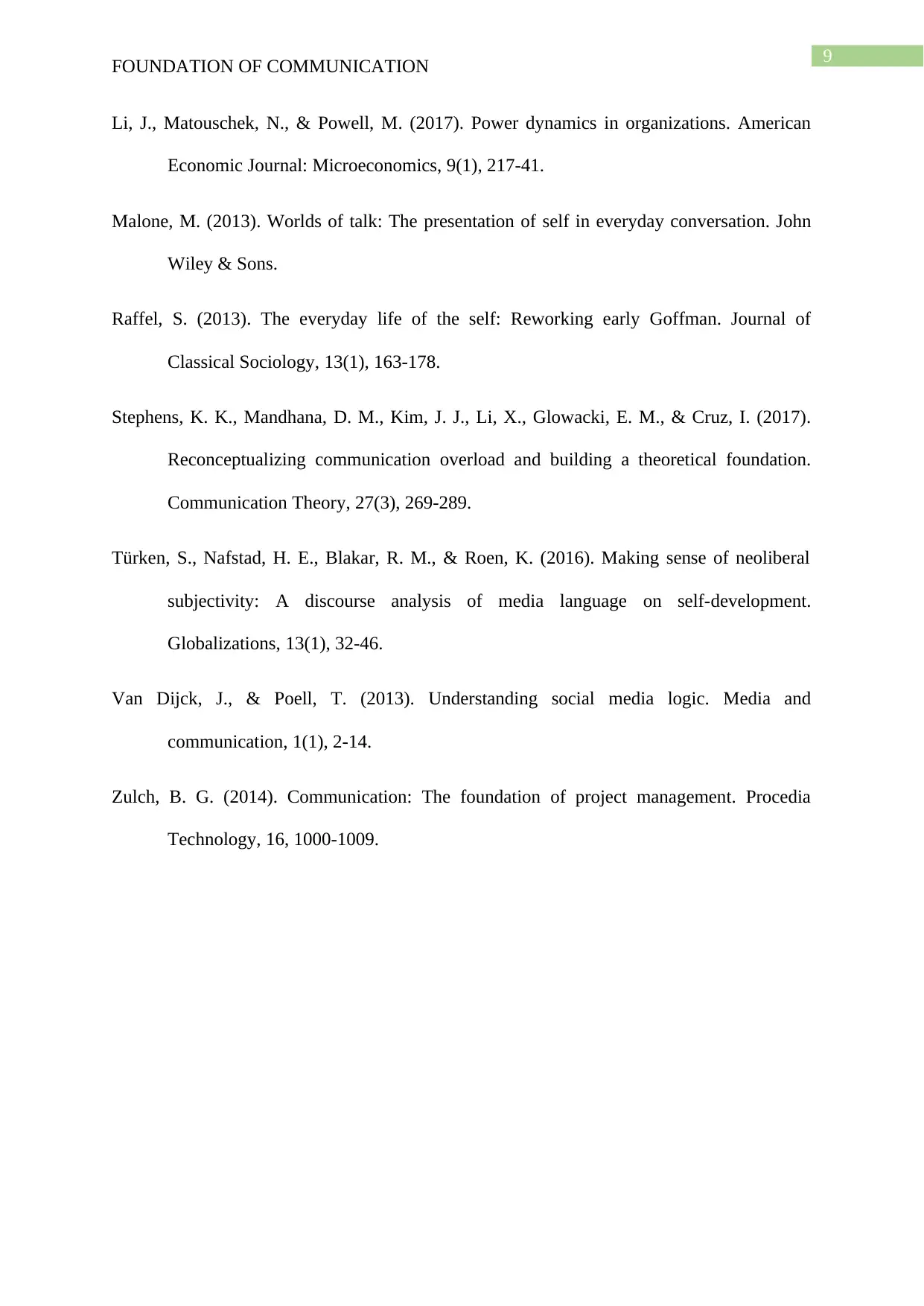
9
FOUNDATION OF COMMUNICATION
Li, J., Matouschek, N., & Powell, M. (2017). Power dynamics in organizations. American
Economic Journal: Microeconomics, 9(1), 217-41.
Malone, M. (2013). Worlds of talk: The presentation of self in everyday conversation. John
Wiley & Sons.
Raffel, S. (2013). The everyday life of the self: Reworking early Goffman. Journal of
Classical Sociology, 13(1), 163-178.
Stephens, K. K., Mandhana, D. M., Kim, J. J., Li, X., Glowacki, E. M., & Cruz, I. (2017).
Reconceptualizing communication overload and building a theoretical foundation.
Communication Theory, 27(3), 269-289.
Türken, S., Nafstad, H. E., Blakar, R. M., & Roen, K. (2016). Making sense of neoliberal
subjectivity: A discourse analysis of media language on self-development.
Globalizations, 13(1), 32-46.
Van Dijck, J., & Poell, T. (2013). Understanding social media logic. Media and
communication, 1(1), 2-14.
Zulch, B. G. (2014). Communication: The foundation of project management. Procedia
Technology, 16, 1000-1009.
FOUNDATION OF COMMUNICATION
Li, J., Matouschek, N., & Powell, M. (2017). Power dynamics in organizations. American
Economic Journal: Microeconomics, 9(1), 217-41.
Malone, M. (2013). Worlds of talk: The presentation of self in everyday conversation. John
Wiley & Sons.
Raffel, S. (2013). The everyday life of the self: Reworking early Goffman. Journal of
Classical Sociology, 13(1), 163-178.
Stephens, K. K., Mandhana, D. M., Kim, J. J., Li, X., Glowacki, E. M., & Cruz, I. (2017).
Reconceptualizing communication overload and building a theoretical foundation.
Communication Theory, 27(3), 269-289.
Türken, S., Nafstad, H. E., Blakar, R. M., & Roen, K. (2016). Making sense of neoliberal
subjectivity: A discourse analysis of media language on self-development.
Globalizations, 13(1), 32-46.
Van Dijck, J., & Poell, T. (2013). Understanding social media logic. Media and
communication, 1(1), 2-14.
Zulch, B. G. (2014). Communication: The foundation of project management. Procedia
Technology, 16, 1000-1009.
Paraphrase This Document
Need a fresh take? Get an instant paraphrase of this document with our AI Paraphraser

10
FOUNDATION OF COMMUNICATION
FOUNDATION OF COMMUNICATION
1 out of 11
Related Documents
Your All-in-One AI-Powered Toolkit for Academic Success.
+13062052269
info@desklib.com
Available 24*7 on WhatsApp / Email
![[object Object]](/_next/static/media/star-bottom.7253800d.svg)
Unlock your academic potential
Copyright © 2020–2025 A2Z Services. All Rights Reserved. Developed and managed by ZUCOL.





